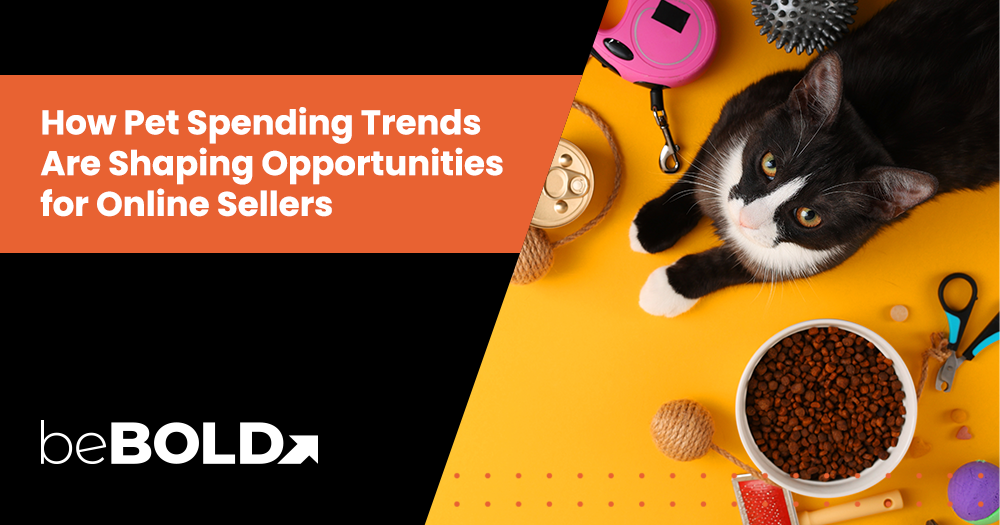As more people consider their pets as part of the family, spending on things like food, healthcare, and wellness products for our furry friends has hit all-time highs. This shift in how we view pets really shows just how strong the market is. For online sellers looking to connect with pet owners, it’s an exciting opportunity to meet this rising demand in a meaningful way.

Key Summary
- The U.S. pet industry reached $152 billion in 2024 and is projected to hit $157 billion in 2025, with steady growth across food, veterinary care, and services. 🐾
- 71% of U.S. households are expected to own pets by 2025, fueling strong demand despite economic uncertainty. 🏡
- The average household spend on pet products rose to $876 in 2023 and is climbing past $900 in 2024, showing the pet industry’s resilience against inflation. 💵
- Younger generations, particularly Millennials and Gen Z, are driving premiumization, e-commerce adoption, and wellness-focused pet purchases. 👩💻👨💻
- E-commerce sales of pet products totaled $28.5 billion in 2024, representing about 22% of the market and continuing to rise. 📦
- Categories like functional treats, supplements, and tech-enabled pet care are gaining traction, creating opportunities for online sellers. 🐶🐱
Pet Populations and Pet-Owning Households
The pet industry is thriving, with ownership serving as its foundation. Currently, about 66% of households in the United States, approximately 86.9 million homes, share their lives with pets, and this figure is projected to climb to 71% (94 million households) as 2025 progresses. While dogs hold the title of the most beloved pets, cats are not far behind. Moreover, pet ownership includes a diverse array of animals, such as birds, reptiles, fish, and small mammals, reflecting our growing affection for all kinds of companions.
|
Year |
% of U.S. Households with Pets |
Estimated Households (Millions) |
|
2022 |
70% |
90.5M |
|
2023 |
66% |
86.9M |
|
2024 |
66% |
86.9M |
|
2025 |
71% |
94M |
Number of Household Owning Pets in US as of 2025
Pet ownership isn’t just universal. It’s also diverse across species. Understanding the distribution of pet households helps sellers identify product opportunities across categories, from food and accessories to specialty care.
- Dog: 68 million households
- Cat: 49 million households
- Freshwater Fish: 10 million households
- Small Animal: 6 million households
- Bird: 6 million households
- Reptile: 6 million households
- Horse: 2 million households
- Saltwater Fish: 2 million households

Source: World Animal Foundation
Pet Ownership Statistics from 2024–2025
Based on the data from the chart, here are the number of households in millions that own each type of pet. The data points are displayed on bars colored in a gradient of orange, with dogs and cats being the most popular pets by a significant margin.
- Dog: 68 million households
- Cat: 49 million households
- Freshwater fish: 10 million households
- Small Animal: 6 million households
- Bird: 6 million households
- Reptile: 6 million households
- Horse: 2 million households
- Saltwater fish: 2 million households
Average Annual Pet Spending
Even with rising prices, Americans are spending more on their pets than ever before. Spending on pets jumped from $136.8 billion in 2022 to an estimated $157 billion by 2025. On average, dog owners now spend over $210 each month on their furry friends, while cat owners spend about $124. This shows how much people are focusing on providing better food, healthcare, and overall well-being for their pets.
|
Year |
Total U.S. Pet Industry Expenditures |
Dogs (Monthly Avg.) |
Cats (Monthly Avg.) |
|
2022 |
$136.8B |
$130 |
$85 |
|
2023 |
$147.0B |
$143 |
$90.50 |
|
2024 |
$151.9B |
$145–150 |
$92–95 |
|
2025 |
$157B |
$210 |
$124 |
Year on year expenditure has also been consistent throughout the years, with pet owners spending a significant percentage of their income for vet services, pet food, and other pet purchases.
Source: US Bureau of Labor Statistics
Who is Spending the Most on Their Pets?
Knowing who spends the most on pets can help online sellers create better strategies. People of different ages, genders, and locations have distinct ways of spending, which shows their lifestyle choices and what they prioritize when buying. Younger people often prefer high-end pet products and are more comfortable shopping online, while older generations tend to brick-and-mortar pet supply shops. Additionally, differences in gender and where people live also influence what products and services are in demand.
Here are some things you can take note of if you’re trying to target pet parents:
Pet Spending by Generation
- Millennials (ages 27–42): The top spenders, accounting for the largest share of overall industry growth. They are most likely to invest in premium nutrition, eco-friendly products, supplements, and pet tech, spending an estimated $1,700+ annually per household - a few hundred dollars more than Gen Zs.
- Gen Z (under 27): Though younger and with less disposable income, Gen Z is rising in influence. In fact, Gen Z holds the highest dog ownership rate per generation at 47%. They favor subscription models, direct-to-consumer pet brands, and are heavily influenced by social media when making purchase decisions. Their buying choices often prioritize sustainability and brand values.
- Gen X (ages 43–58): Steady spenders who balance convenience with value. While they still rely on brick-and-mortar stores, they are increasingly embracing e-commerce for recurring essentials.
- Boomers (59+): More conservative spenders but represent a large pet-owning base. They allocate more to veterinary services and essential care than accessories or tech, providing a consistent revenue stream in core categories.
Pet Spending by Gender
Surveys show women are more likely to spend on pet accessories, grooming, and wellness, contributing significantly to discretionary and lifestyle product categories.
Men, while fewer in number as primary purchasers, slightly outspend women on tech-enabled products, training tools, and larger-ticket equipment.
Pet Spending by Region
- Urban pet owners typically spend more, particularly on premium food, grooming, daycare, and convenience services that fit fast-paced lifestyles. Higher cost of living and trend adoption rates drive this spending.
- Suburban owners often represent a blend of premium purchases and practical essentials, investing heavily in food, preventive care, and accessories for family-oriented pets.
- Rural owners spend more on bulk food, outdoor-related pet care, and farm-adjacent supplies but are less likely to invest in luxury services or tech-driven products.
-
In 2023, the Midwest led statistics on annual spend per household - spending more than $1,000 on pet care. It is followed closely by the Northeast, with average household pet care spending at $800.
|
Region |
Avg. Annual Spend |
% of Income Spent |
|
Midwest |
$1,160 |
1.25% |
|
Northeast |
$800 |
0.80% |
|
West |
$720 |
0.72% |
|
South |
$705 |
0.73% |
Pet Product Spending Over Time: What to Expect
The pet industry has been growing steadily, showing that people are dedicated to taking care of their pets, even when times are tough economically. In just a few years, spending on pets has increased by over $20 billion, indicating that the demand for pet products and services is not only stable but also expanding in various areas.
- Food and treats are still the biggest part of this market, expected to reach nearly $68 billion in 2025. Meanwhile, veterinary care and pet products are projected to approach $41.5 billion.
- Shopping online for pet items continues to rise, with new digital brands taking market share from traditional retailers. This 2025, around 51% of buyers typically course their pet product purchases through online stores, such as Walmart and Amazon.
This continued growth highlights not only the resilience of pet owners but also the openness to new ideas in the industry. It points to great opportunities for sellers who can adapt to changing consumer needs and effectively use online platforms.
Don’t miss the rising demand — partner with beBOLD Digital today to accelerate your success. We not only help brands get started but also expedite their road to long-term growth and profitability.
Why These Trends Matter: Turning Insights into Sales

People’s spending on pets isn’t just a reflection of what they like; it also shows where online sellers can find good business opportunities. As households keep spending more on their pets, it’s clear that pet care has become an important part of everyday life. For online brands, this means they can market their products as must-haves instead of just treats. This is especially true for items that relate to health, eco-friendliness, or making life easier.
For online sellers, pet spending trends reveal actionable opportunities:
- Focus on Quality: Pet owners are treating their pets more like family, so they want the best products. When writing descriptions for pet products, emphasize benefits like helping joints move better, improving digestion, or providing calming effects.
- Savings through Bundles: With rising prices, pet owners are looking for ways to save money. Offering subscription services or bundle deals can be appealing because they allow customers to stock up on their pet's favorite items at a better price, which can encourage them to stay loyal to your brand.
- Online Shopping Growth: Major retailers like Amazon and Walmart are still the go-to places for pet supplies. By using popular search terms like "premium dog food," "cat vitamins," and "eco-friendly pet toys," you can attract more customers. Advertising through digital channels and Amazon means helps ensure more people see your products.
- Power of Social Media: Platforms like TikTok and Instagram are great for getting the word out, especially to younger audiences. Businesses that work with social media influencers, encourage user-generated content, and create engaging campaigns can quickly boost sales and improve their brand’s visibility.
- Health-Related Products: Items that promote pet health, like dental chews or flea and tick preventatives, do well when paired with helpful educational material. Positioning these products as smart choices can help pet owners save money on veterinary visits in the long run.
Take Advantage of Pet Spending Trends and Start Scaling Your Brand With beBOLD Digital
The pet industry is not only growing but also changing in exciting ways. As spending on pet products continues to rise, online sellers have a fantastic chance to attract more customers by focusing on what people care about most: health, sustainability, and convenience. For brands wanting to succeed on Amazon, it’s important to find a good balance between offering high-quality products and affordable options that appeal to both younger shoppers like Millennials and Gen Z, as well as older generations like Gen X and Boomers.
At beBOLD Digital, we assist pet brands in improving their online product listings, making the most of their advertising budget, and achieving better visibility in search results across different platforms. If you're ready to elevate your pet brand and reach more customers, get in touch with us today!
Frequently Asked Questions
Has inflation affected how much people spend on pets?
Yes. While inflation raised costs, average annual spending still rose from $136B in 2022 to approximately $157B in 2025, showing pet care remains non-negotiable for most households.
Are pet owners spending more on luxury or premium products?
Absolutely. Millennials and Gen Z are driving premiumization - choosing functional foods, supplements, and eco-friendly products even at higher prices.
Do pet owners in urban areas spend more than rural owners?
Yes. Urban owners typically spend more on services like grooming, walking, and premium diets, while rural owners lean toward bulk essentials.
Is there a difference in spending between dog and cat owners?
Yes. Dog owners spend more overall (averaging about $210 per month versus $124 for cats) driven by higher food and healthcare costs.
How are younger generations influencing pet spending?
Gen Z and Millennials prioritize wellness, tech-enabled pet care, and subscription convenience. They’re also heavily influenced by social media trends.
What role does social media play in pet spending?
Social platforms, especially TikTok and Instagram, drive viral trends in pet toys, accessories, and treats, boosting online sales rapidly.
Are pet services (like grooming and vet care) growing faster than products?
Services are steadily increasing, with vet care nearing $41B in 2025. However, food and treats still lead to total spending. The fastest growth is in preventive and wellness products linked to veterinary concerns.











Comments